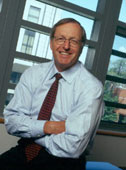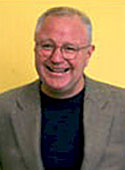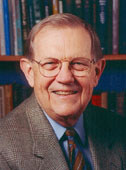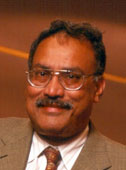Leadership Lessons from Shakespeare

Jim Fisher
|
An enthusiastic group of 26 surgeons
and surgical nurses gathered
to hear stimulating lessons
on Leadership Day for surgeons,
held at the Vaughan Estate on
April 24, 2009. Jim Fisher, Vice
Dean, Programs at the Rotman
School of Management developed
the theme that "leadership
is thoughtful; it is not about charisma". Using the
example of King Henry V as portrayed by Shakespeare,
Jim developed his nine-block conceptual framework for
successful leadership in action, illustrated in a nearby
figure. Henry's management included careful planning.
He chose the site of battle to be a tapered field where
the overwhelming numerical superiority of the French
could be confounded. They stumbled over each other
in the mud as they approached the small end of the
funnel where the English troops stood their ground.
He organized the structure - sharpened wooden spears
were positioned diagonally in the ground to impale the
French horses as they charged. He assembled the required
team of long-bow archers, a novel weapon, far superior
in accuracy and range to the cross - bows used in the past.
These were positioned safely between the spears. The
arrows that he brought from England, made of Spanish
yew, would not shatter when they struck their targets.
The leading component of his action plan included
a vision of the future in which generations would look
back at the heroism of his troops and see them as noblemen.
He aligned a heroic group of committed fighters
by telling those who did not share the motivation of
the heroic "happy few" that they should take their pay
and leave. This eliminated those who might be seditious
or troublesome. He appealed to the soldiers'
self-esteem and sense of belonging by
placing himself in the front
line - neutralizing any doubts about his commitment.
In engaging his troops, Henry articulated and lived the
values consistent with his vision of a band of heroes.
Jim recommended the book Leadership and the Quest
for Integrity by Badaracco and Ellsworth as the best book
available on leadership. (1) It emphasizes involvement.
Followers need to control their space. The Political
theory of leadership requires that we give followers their
choice within the boundaries of the leader's plan. Good
followers are volunteers who have chosen to do their
work. "If you pay them and walk around to check on
them, you'll get the minimum - while you are watching.
They have to choose to volunteer for the rest."
The Directive theory of motivation states that we want
decisions from the boss, even if we don't agree. Leaders
should make decisions on issues people want decided -
"We'll do X by Y." Values are important; we feel better about
ourselves if we are doing X. Good leaders manage, lead and
engage. Too idealized a vision is discouraging. "World class
care for everyone immediately" sends everyone home feeling
like losers. Make the vision achievable, not unrealistically
ideal. He commented that we in healthcare treat each
other badly compared to the business community. We are
doing heroic work, and it should be far easier to inspire each
other. When he was working for Neilson, he felt that the
company dealt with its customers and co-workers better,
even though the motivating values and vision were far less
heroic. "Stuffing Mr. Big bars down the throats of boys, and
Caramilk down the throats of girls - stuffing fat and sugar
into people isn't highly motivating, so we pushed the idea
that it's Canadian and that we deal with our customers and
co-workers better than other companies."
"In the political world Obama did all three leadership
tasks well (managing, leading, engaging). He was always
clear, always on plan. Stephane Dion couldn't do the manage
part, though he was fine on the others. John McCain
and Hillary Clinton couldn't manage the plan." The vision
sometimes changes so the thoughtful leader adjusts to the
situation, the resources and the purpose. Leaders use objective
left-brain corporate considerations as they measure
output, and subjective personal right-brain approaches
when they look to the authenticity of their leadership.(2)
They use the left and the right brain to determine who
they have to get on-side. Objective information is easy to
obtain. Emotional intelligence is more critical to success.
In Henry V, the king walks around disguised in a cloak the
night before the battle, listening to learn what the soldiers
won't tell him. They believed that the king will be ransomed
if captured, a common practice at that time; that the plan
was bad, and that God did not favour their enterprise. His
speech counters all these misconceptions.
Download text of this
speech
Link to the video clip of Kenneth Branagh's delivery.
Analyzing the resources of the leader, there were objective
resources like long bows, shatter-proof arrows and
physical geography. There were also emotional, right brain
resources. In the long line of the many French
kings who had ruled England since 1066 Henry V was
the first who could speak the Anglo-Saxon language. He
was credible to his men, based on his emotional intelligence
(3) and knowledge of their culture from his days
of carousing in bars.
THE THOUGHTFUL LEADER'S WORKBOOK:
(Click for full size image)
The Matrix Revisited

Brendan Calder
|
Brendan Calder led us through
a spirited exercise utilizing his
famous Responsibility Matrix.
(4) This management tool
identifies for each management
decision: 1. who is Responsible
for getting it done; 2. whose
Consensus is required; 3. whose
Input is required; 4. who does
the Work; 5. who must be
Advised Before; and 6. who must
be Advised Later. Bryce Taylor replaced the surgical
exercise planned for Brendan's analysis with the group
by introducing the news - fresh that day - of the H1N1
influenza epidemic. Participants had fun struggling with
this exercise; it clearly demonstrated how failure to assign
and articulate individual responsibility when a decision
is made can delay and/or prevent its implementation.
Here are some key recommendations that are not typical
of our decisional policymaking processes: "assign only
one R"; "minimize the number of Cs"; "define consensus
clearly - consensus means parties may still like their own
differing opinions but are willing to commit to and
support the proposed decision".

Miles Shore
|
Miles Shore, Professor of
Psychiatry at Harvard Medical
School and an affiliate of the
Centre for Public Leadership,
Kennedy School of Government
at Harvard, developed the
theme of senior leadership teams to augment, intensify, or
supplement the impact of the
thoughtful individual leader.
He cited the work of the Hay
group, with Richard Hackman of Harvard (5), which
reports a study of senior teams in a variety of industries.
Senior leadership teams can be informational, like the
Alcoa team that met every Monday morning on a worldwide
conference call to inform the CEO, consultative- advising the CEO on strategy and
management, coordinating- integrating and aligning different divisions
within the organization, or decision-making. Decision-making
teams can do all four of the functions and may
be extremely effective if they are properly organized
and supported by top leadership. The Senior Advisory
Committee of the Department of Surgery, comprised
of all of the University Division Chairs and Surgeonsin-Chief is an excellent example of a decision-making
team. Miles emphasized that senior leadership teams are
needed during periods of rapid growth, when new areas
of activity are taken on by the organization, when major
capital expenditures are contemplated or when entering
a new stage of the organization's life cycle.
It is critical that the senior leadership group be a real
team and not a pseudo team, that is, members must have
the skills and knowledge required, and the participants
must know that they are members of a team - it should
not include ex officio members. A well-functioning team
requires stability, and consistent support by the leader of
the organization. All members should come to all meetings
and the team should have significant tasks. Each
member of the team should add value regarding the
purpose of the organization, and the team should have
a compelling direction to pursue, rather than simply a
schedule of pro forma meetings.
|
Team enablers include a structure of the right size,
eight to nine people, and a focus on the whole organization
rather than its contending parts. Lincoln accomplished
this at a national level by changing the language
describing the United States. After the Gettysburg
Address, the standard usage became "the United States
is," rather than "the United States are." Additional
enablers include a supportive context with sufficient
resources and logistic support, and team coaching. This
should come from the team and from the CEO, including
debriefing summaries of each meeting which then
serve as the agenda for the next meeting. This is classic
Brendan Calder "get it done" technique. (4)
To illustrate the formation of a senior team, Miles
tied together the Jim Collins theme from Jim Fisher's
talk on Henry V. "You need to get the right people on
the bus and the wrong people off the bus." (6) He told
us that Henry V chose the right group of senior leaders
to join him at Agincourt, bypassing his troublesome
brother Thomas, Duke of Clarence. Thomas was their
father's favourite, and had made a military alliance with
elements of the French aristocracy, generating suspicion
that he was trying to set up a political regime in France
in opposition to Henry. When early in Henry's reign
various perquisites were bestowed, Thomas was deprived
of what he had expected, and was only bought off by
large amounts of money, and some lesser titles. Henry
went further outside the immediate royal family to
build his senior leadership team, basing appointments
on merit rather than nepotism or the conventions of
the noble hierarchy. He chose a relative outsider, Henry
Chichele, as Archbishop of Canterbury on the basis of
his legal expertise and loyalty rather than the more flamboyant
but headstrong and ambitious Henry Beaufort,
the expected candidate. His "senior team" of leaders in
the French campaign was made up of experienced warriors,
men who had succeeded in suppressing the Welsh
uprising. These seasoned leaders brought with them not
only expert archers and armoured men-at-arms but,
more important, their own experience in war to ensure
the success of Henry's campaign.
Larry King interviews Bryce Taylor

Joe D'Cruz
|
Leadership Day closed with a
spirited imitation of Larry King,
including the red suspenders, by
Rotman Professor of Strategy
Joe D'Cruz interviewing Bryce
Taylor about his ten-year term
as Surgeon-in-Chief at the
University Health Network.
One of the first lessons that
Bryce learned is that you must
express your strong opinions in
a committee meeting, but if the consensus opinion
about a subject differs from your own, you must enthusiastically
support that opinion and decision when the
meeting is over.
Painfully, he had to make the cuts that go with a deficit
budget during the last recession, though many felt the
hospitals might have succeeded despite the submission
of deficit budgets. Bryce finds cuts in budget deeply disturbing;
a 2% budget cut may mean an 8 or 9% reduction
in care, because in 2009, reductions in service also
lead to reductions in revenue in
a volume-funded system.
He described a good example
of Jim Collins' removal of "the
wrong people on the bus." (An
innovative and disruptive surgeon
once created a new device
to use in the operating room.
He proceeded to use it over
the nurses' objections, and this
ultimately led to a suspension of
privileges. The disrupter eventually "found a new bus").

Bryce Taylor
|
"Being surgeon-in-chief is a tough job, but there are
now eight or nine excellent candidates" - a testament
to the respect, efficiency and followership Bryce has
brought to the position of Surgeon-in-Chief. Bryce says,
"I have the best surgical job in the country. The various
clinical and academic outputs of our surgeons are phenomenal.
I view my success as the success of others. I get
a tremendous kick out of the success of other surgeons,
like seeing Steve Gallinger's cadre of four young stars
take hepatobiliary and pancreatic surgery up a level, or
recruiting as our new head of plastic surgery Stephan
Hofer, who actually was the star of a daily reality TV
show in Holland, in addition to being an outstanding
reconstructive surgeon and leader."
Larry King asked Bryce to explain how the transformation
from "just a surgeon to leader" developed.
"After my clinical general surgery training in Toronto, I
went to England where I engaged in basic research, and
then started my career at Toronto Western Hospital
where I performed a wide variety of operations in general
surgery. During my time at Toronto Western, I was
the year 2-3 coordinator for the medical students, then
became director of post-grad education for all U of T
surgical residents. There were no specialty program
directors at the time, so I interviewed each and every
resident entering all specialties and also throughout
his/her training, trying to provide the best experience
possible for about 150 residents! From 1989-99 I was
Chair of General Surgery for the 10 university hospitals
- a position characterized by lots of responsibility but
with little authority and no budget. For the past ten
years I have been the Surgeon-in-Chief and Director
of Surgical Services at UHN. The latter job involves a
commitment to finances, quality of care, and workload
of everyone who works in surgery. I never really sought
any job I eventually took on - I did them to learn,
for a challenge, because they were interesting, and
because I could see certain areas where there was a job
to be done. It sure was a challenge when I was Chair
of General Surgery and Division Head at UHN, we
introduced the liver transplant program, we were flying
all over Canada and the US to harvest organs, we
always had challenges of doing more with less, and at
the same time I remembered that I had a large family
whose members saw too little of their Dad!
Work with independent, individualistic physicians
and surgeons is always a tightrope walk. As independent
practitioners, none of us likes change. As an example,
the surgical checklist project, which may reduce the incidence
of complications by 4%, and has numerous welldocumented
advantages as reported in the NEJM, (7,
8) has not been universally adopted. Despite being easy
and cheap, the checklist has not yet been embraced in
North America with the enthusiasm that was predicted;
the challenge was laid that 4000 hospitals in the US
would adopt the surgical checklist within three months
of the publication of NEJM article, but to date only a
small proportion of that number have implemented it.
We have an opportunity at the University of Toronto to
lead the continent!"
The evaluations of Leadership Day were enthusiastic.
Jim Waddell wrote:
"In my previous leadership positions I was fortunate
to know most of the individuals with whom I worked
and was able to bring about change through personal
connection. In my new position as the Lead for the
Expert Panel for Orthopaedic Surgery in the Province
of Ontario I am largely working with individuals
throughout the province with whom I do not have a
personal connection and often have little understanding
of the local circumstances that influence or direct
their behaviour.
I attended this leadership session because I wanted
to know more about large, complex organizations, how
they are run and the decision-making processes they
use to set priorities. This is particularly relevant with
many of the large hospital corporations responsible for
delivering orthopaedic care throughout the province as
well as the 14 LHINs that are expected to coordinate the
actions of the respective hospitals within their borders.
This course offered valuable insights into corporate
decision making and those points along the process of
concept, planning and implementation where one might
influence the ultimate result and augment the leadership
of others."
M.M.
(1) Badaracco, Joseph and Ellsworth, Richard. Leadership
and the Quest for Integrity. Boston: Harvard Business
Review Press, 1993.
(2) George, Bill. Authentic Leadership: Rediscovering the
Secrets to Creating Lasting Value. Jossey-Bass, 2004.
(3) Goleman, Daniel. Emotional Intelligence. New York:
Bantam. 1997
(4) See page 13 at http://www.surgicalspotlight.ca/Shared/ PDF/Summer07.pdf
(5) Wageman, R, Nunes, D, Burruss, J and Hackman JR.
Senior Leadership Teams. What it takes to make them
great. Harvard Business School Press.2008. 241 pp.
(6) Collins, Jim. Good to Great: Why Some Companies Make
the Leap ... and Others Don't. New York: HarperCollins,
2001.
(7) http://www.surgicalspotlight.ca/Article. aspx?ver=Winter_2009&f=Main
(8) Hayes AB, et al. A Surgical Safety Checklist to Reduce
Morbidity and Mortality in a Global Population. New
England Journal of Medicine Jan. 29, 2009;360(5):491-499.
|